Australia Last Mile Delivery Market Size
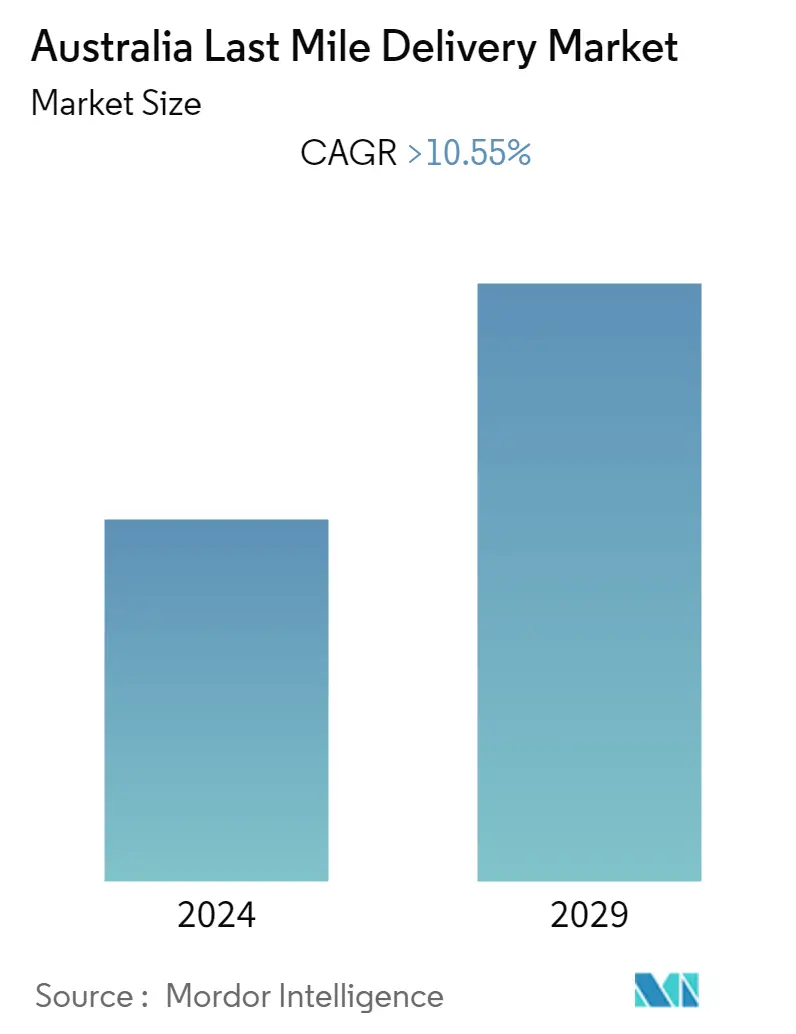
| Study Period | 2020 - 2029 |
| Base Year For Estimation | 2023 |
| Forecast Data Period | 2024 - 2029 |
| Historical Data Period | 2020 - 2022 |
| CAGR | > 10.55 % |
| Market Concentration | Medium |
Major Players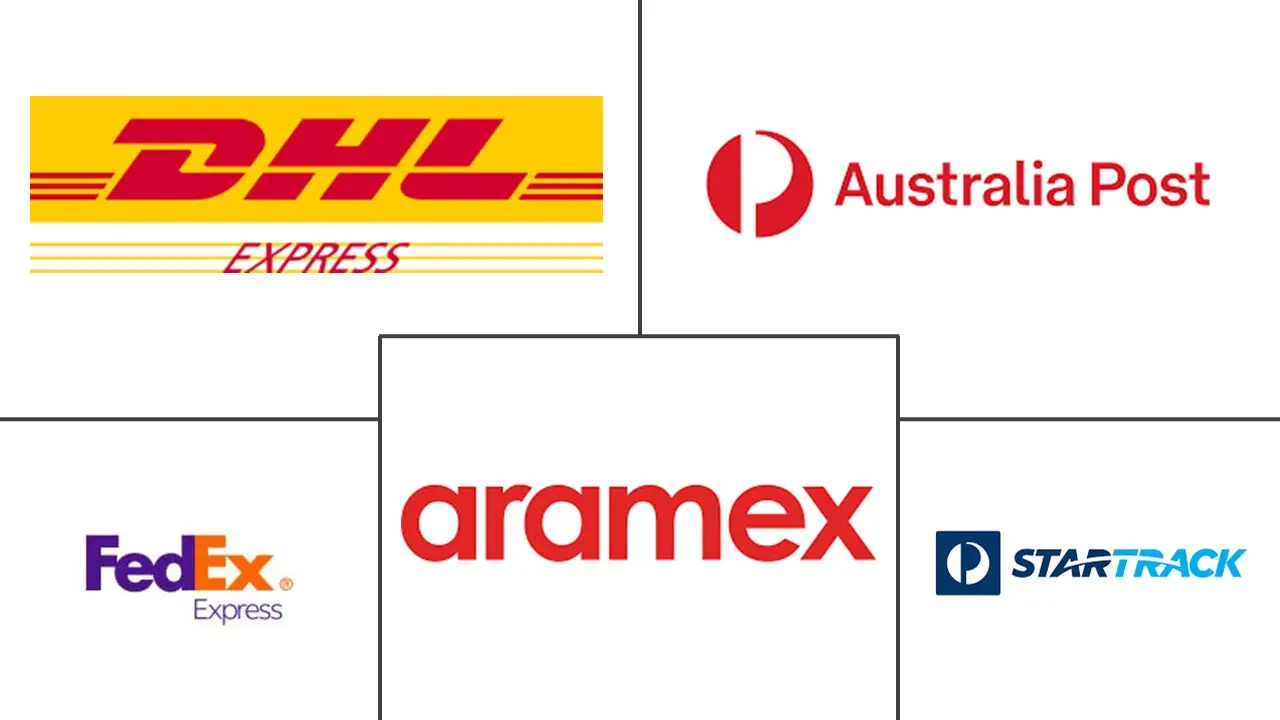
*Disclaimer: Major Players sorted in no particular order |
Need a report that reflects how COVID-19 has impacted this market and its growth?
Australia Last Mile Delivery Market Analysis
The Australia last mile delivery market is expected to record a CAGR of more than 10.55% during the forecast period, 2022-2027.
The COVID-19 pandemic caused worldwide lockdowns, disrupted commercial activities and challenged the economy but created widespread opportunities for the last mile delivery market in Australia. There was a shift in consumer buying behaviour causing a surge in e-commerce retail sales fueling the powerful opportunity for logistics industrialists to push through real and lasting change. COVID-19 triggered exponential growth in e-commerce and spurred many smaller retailers to utilize the supply chain mechanism to deliver their products directly to consumers. According to the Australian Bureau of Statistics, online sales in Australia registered a 55% rise in December 2020 compared to the same period last year. Australia Post's Online Shopping Report published in January 2021 reveals that over 5.6 million Australian households shopped online in December 2020, a 21.3% growth compared to the 2019 average. A 2020 global study showed on average 22% of people shopped online weekly, up from 17% in 2019, Australia exceeded the global average with 26.5% giving surplus opportunities to logistics sector.
The online retailing boom has driven logistics occupiers in Australia to consider different ways to manage last mile logistics requirements in the country. Amid E-commerce growth rates, the last mile has become a critical aspect of the supply chain. Demand for 'last mile' is led by grocery giants like Coles and Woolworths. Coles reported 48% growth in e-commerce sales in their 2021 half yearly result, generating USD 1.0 billion in sales revenue. Similarly, Woolworths reported USD 1.8 billion in e-commerce sales and 91.8% growth rate over H1 2020. Woolworths also accounted that average weekly traffic to digital assets increased 62.4% to 20.2 million visits per week, as customers increasingly looked to engage digitally as part of their shopping experience.
Consumer demand for omnichannel offerings has accelerated as Australia continues to close the gap on leading e-commerce countries. Gaining market share will require a customer-centric and economically sustainable supply chain. Companies such as Australian based, DriveYello, Zoom2U, Sendle and Sherpa are stepping in to fulfil 'the last mile' requests. These companies allow private drivers/cyclists to become couriers and thus have an incredible network to make point-to-point deliveries. And with an easy to use interface, an offer of USD 11 same day delivery (and 3 hours in metropolitan regions), these start-up couriers are disrupting 'the last mile' market for the benefit of online retailers. Uber is also venturing into the space with UberRUSH - effectively utitlising their network of Uber drivers to act as couriers for retailers. The ongoing evolution of the supply-chain will continue to drive the pursuit of 'last mile' logistics solutions.
Australia Last Mile Delivery Market Trends
This section covers the major market trends shaping the Australia Last Mile Delivery Market according to our research experts:
Developing e-commerce industry fueling the demand for last mile logistics
The growth in online retail and e-commerce usage has become one of the hottest topics in recent times in Australia. While the pandemic has accelerated the shift to e-commerce by up to five years, expansion in the sector was already well underway. Australia Post 2020 e-commerce Industry Report stated that for March 2020, total retail spending was up by 15.5% YOY and 13.7% in February 2020, with this growth largely driven by bulk purchases in food retail. Over March, online also saw strong growth, accounting for 12.3% of total retail spend, compared to 11.3% in 2019. In April 2020 online purchases grew 6.8%, when compared to the 30 days to 18 Dec 2019.
Grocery retailers looking to fill online orders more efficiently are rolling out new logistics solutions in a bid to ramp up their order volumes in urban areas. Australia is the eleventh largest market for eCommerce with a revenue of USD 31.3 billion in 2021, placing it ahead of Russia and behind of Canada. With an increase of 15%, the Australian e-commerce market contributed to the worldwide growth rate of 15% in 2021.
Online shopping growth for the 2020-21 financial year rose by 31.8% over the previous year, following a similar climb in 2019-20, when sales lifted 33.2%. Pet products, baby products and homewares and appliances led the charge, with online sales for products in that sector growing by 46% year over year. during the first three weeks of the 2021 lockdown in NSW, online shopping increased by 36% over the same period last year.Victoria was the top driver of online sales from July to October of 2020, mirroring the duration of the state's longest lockdown. Over the course of the year, Victorians purchased almost as much as shoppers in NSW from online retailers, despite a smaller population, with 30% of overall spending coming from the state.
The first significant spike in online growth tied to the pandemic was recorded in April 2020, when food and liquor and home and garden purchases more than doubled compared to 2019.Those categories showed above-average annual growth again this year, perhaps hinting at both the necessities Australians were ordering in, as well as the hobbies they'd picked up with more time at home.Overall, 9.1 million households participated in e-commerce between 1 July 2020 and 30 June 2021, which means that roughly 90% of Australians either already shop online or live with someone who does.
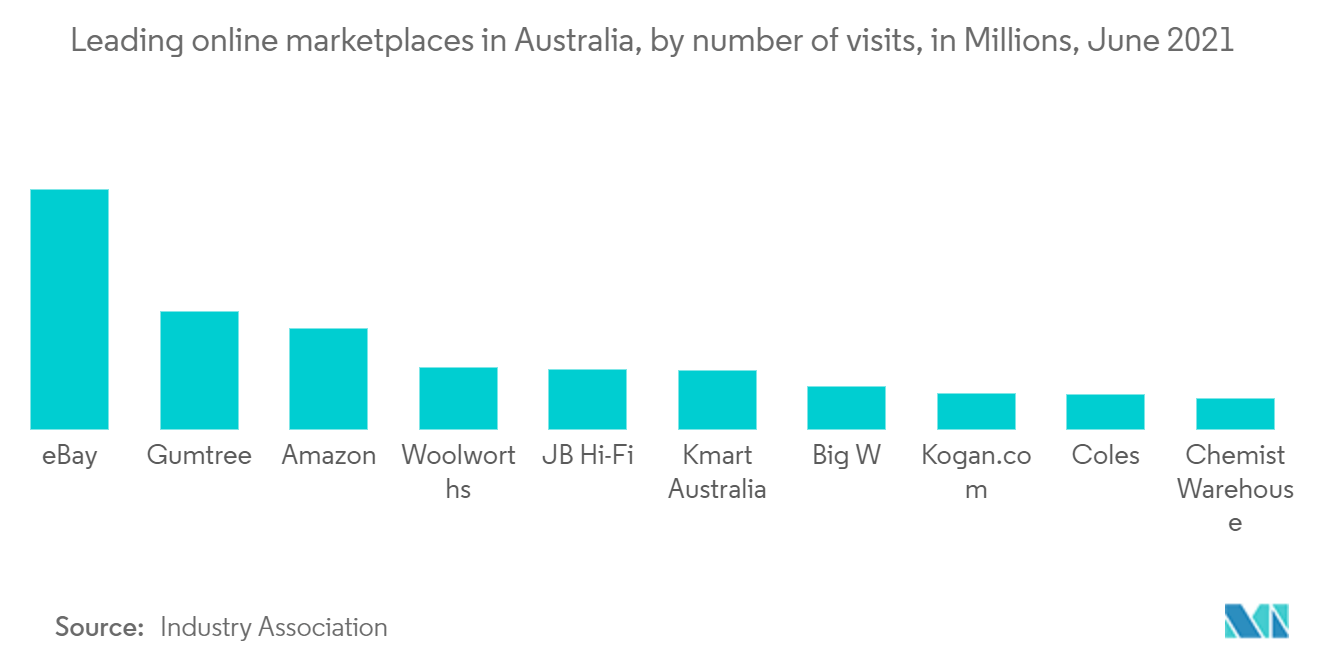
Growing cross-border trade relations with other countries on various industries
In August 2020, Singapore and Australia signed the digital economy agreement that will open up economic opportunities for both countries. The Singapore-Australia Digital Economy Agreement (Sadea) builds on Singapore and Australia's strong bilateral trade and investment flows to enhance economic opportunities in the digital realm. The agreement builds on Australia's and Singapore's leading roles in negotiating new international rules on e-commerce in the World Trade Organisation (WTO), to better facilitate the growing volumes of digital trade across the globe. It is the second digital economy pact that Singapore has signed, following the Digital Economy Partnership Agreement with Chile and New Zealand in June 2020.
The Government has invested more than USD 3.5 billion in digital initiatives since 2020. In addition, the Government has invested USD 1.67 billion under the Cyber Security Strategy 2020, USD 4.5 billion for the NBN upgrade plan, USD 1 billion for the JobTrainer Fund and over USD 2 billion in further complementary investments in this Budget for connectivity in regional and remote Australia, improving online safety and building skills.
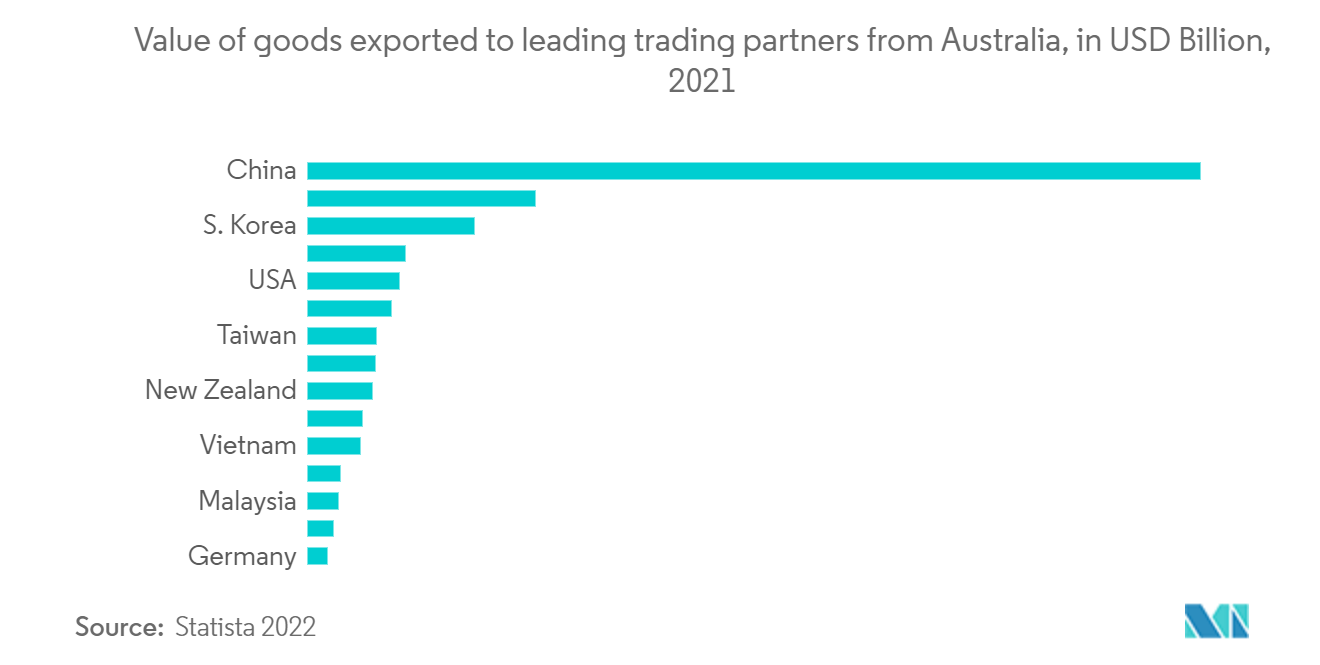
Australia Last Mile Delivery Industry Overview
The Australian last mile delivery market is highly competitive, with the presence of major international players. With a few players holding a significant share, the Australian Australian last mile delivery market has an observable level of consolidation. The market is dominated by top carriers, namely, Australia Post, DHL Express, FedEx Express Australia, Aramex Australia and StarTrack.
Several start-ups are entering the market to leverage digital technologies, there is a trend of large companies acquiring these start-ups to gain a significant footprint in the market. Local startups include Pack and Send, Rush Express. Logistic Service, Whale Logistics, G&S Logistics, 20Cube Logistics PTY LTD, Consolidated Freight Australia, OMNIA Logistics and many more.
There is a growing trend of mergers and acquisitions in the industry, as suppliers seek to attract volume and extend their network in order to deal with the growing parcel demand. For instance, Australia Post has formed an alliance with Aramex, Alibaba, China Post and Qantas for global e-commerce delivery capabilities.
Australia Last Mile Delivery Market Leaders
Australia Post
DHL Express
FedEx Express Australia
Aramex Australia
StarTrack
*Disclaimer: Major Players sorted in no particular order
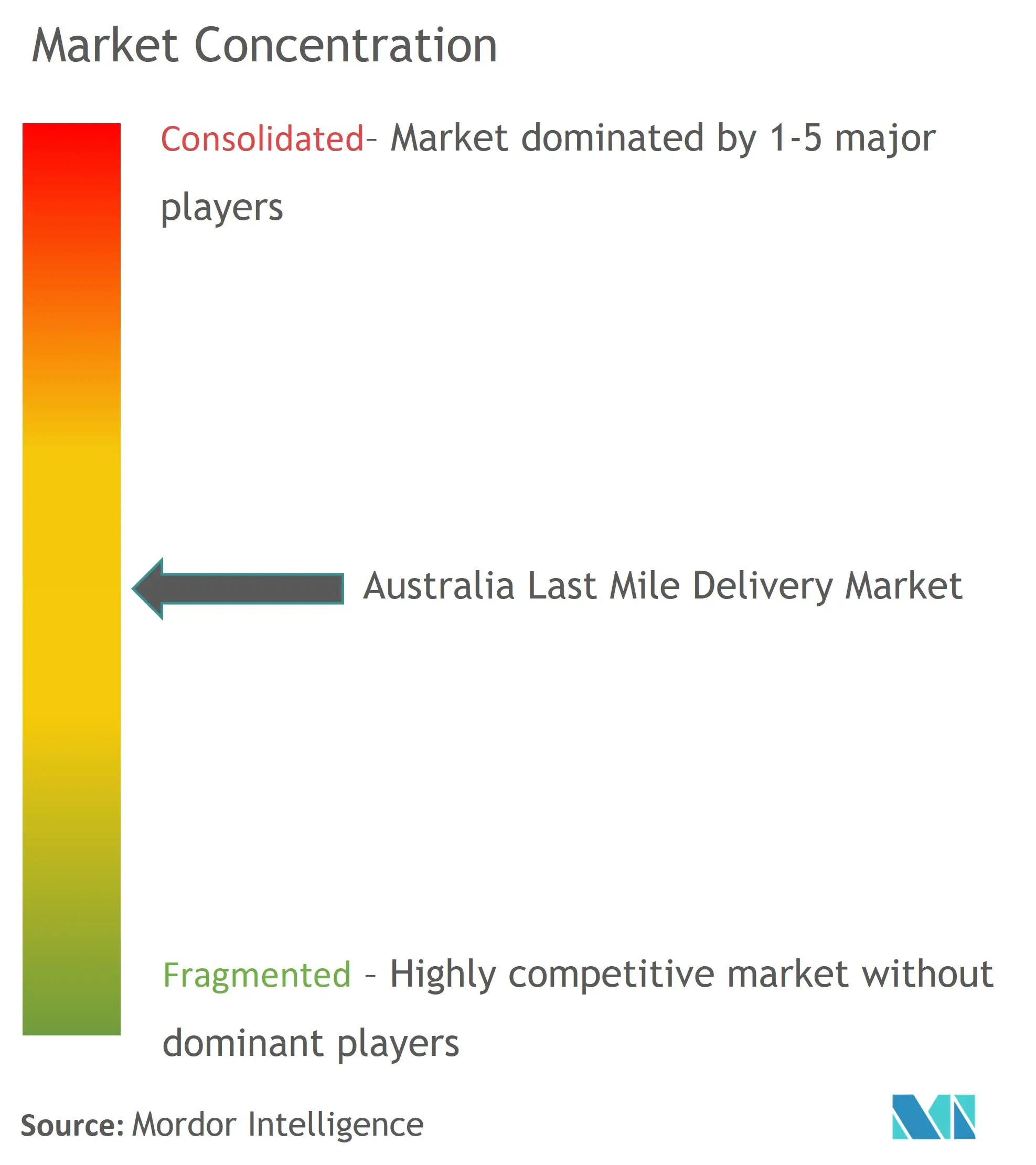
Australia Last Mile Delivery Market News
July 2022: Woolworths has unveiled a multi-million dollar Customer Fulfilment Centre (CFC) in Brisbane, Queensland. The10,000sqm purpose-built warehouse facility sits 18km from the CBD at Goodman's Rochedale Motorway Estate and has space for 25,000 products. The company says this is the only CFC facility in its network to offer a Direct-to-Boot service. Combining deliveries and pickups, the company expects to fulfil 30,000 customer orders a week.
March 2022: Arcimoto and Directed Technologies Launch Pilot Program to Introduce Ultra-efficient Electric Delivery Vehicles into Australia. This opportunity will lead on two levels: Directed's class-leading digital fleet management technologies and Arcimoto's rightsized electric vehicle, which together can optimize last-mile delivery options for the clients while fitting seamlessly within their sustainability and technology vision.
Australia Last Mile Delivery Market Report - Table of Contents
1. INTRODUCTION
1.1 Study Assumptions
1.2 Scope of the Study
2. RESEARCH METHODOLOGY
2.1 Analysis Method
2.2 Research Phases
3. EXECUTIVE SUMMARY
4. MARKET INSIGHTS DYNAMICS
4.1 Current Market Scenario
4.2 Market Overview
4.3 Market Dynamics
4.3.1 Drivers
4.3.2 Restraints
4.3.3 Opportunities
4.4 Value Chain / Supply Chain Analysis
4.5 Porter's Five Forces Analysis
4.5.1 Threat of New Entrants
4.5.2 Bargaining Power of Buyers/Consumers
4.5.3 Bargaining Power of Suppliers
4.5.4 Threat of Substitute Products
4.5.5 Intensity of Competitive Rivalry
4.6 Technological Trends and Automation in Last Mile Delivery
4.7 Government Regulations and Initiatives
4.8 Insights into Industry Value Chain
4.9 Insights into E-commerce industry in Australia
4.10 Insights into Cross-border trade of Australia with other countries
4.11 Impact of COVID-19 on the Market
5. MARKET SEGMENTATION
5.1 By Type
5.1.1 B2B
5.1.2 B2C
5.1.3 C2C
5.2 By Delivery Mode
5.2.1 Regular Delivery
5.2.2 Same-day Delivery
5.2.3 Express Delivery
6. COMPETITIVE LANDSCAPE
6.1 Market Concentration Overview
6.2 Company Profiles
6.2.1 Australia Post
6.2.2 DHL Express
6.2.3 FedEx Express Australia
6.2.4 Aramex Australia
6.2.5 StarTrack
6.2.6 Sendle
6.2.7 CouriersPlease
6.2.8 Allied Express
6.2.9 Pack & Send
6.2.10 Toll
6.2.11 Rush Express
6.2.12 Whale Logistics
6.2.13 Omnia Logistics
6.2.14 CBIP Logistics
6.2.15 Admiral International*
- *List Not Exhaustive
7. FUTURE OF THE MARKET
8. APPENDIX
Australia Last Mile Delivery Industry Segmentation
Last mile delivery refers to the last leg of logistics operations. A product's journey from a warehouse to the doorstep of the end customer. This last step of the delivery process is most critical and should be well managed for the speedy shipping. A complete background analysis of Australia's last mile delivery market, including the assessment of the economy and contribution of sectors in the economy, market overview, market size estimation for key segments, and emerging trends in the market segments, market dynamics, and geographical trends, is included in the report.
The Last Mile Delivery Market is segmented By Type (B2B, B2C, C2C), By Delivery Mode (Regular Delivery, Same-day Delivery, Express Delivery). The report offers market size and forecasts in values (USD billion) for all the above segments.
| By Type | |
| B2B | |
| B2C | |
| C2C |
| By Delivery Mode | |
| Regular Delivery | |
| Same-day Delivery | |
| Express Delivery |
Australia Last Mile Delivery Market Research FAQs
What is the current Australia Last Mile Delivery Market size?
The Australia Last Mile Delivery Market is projected to register a CAGR of greater than 10.55% during the forecast period (2024-2029)
Who are the key players in Australia Last Mile Delivery Market?
Australia Post, DHL Express, FedEx Express Australia, Aramex Australia and StarTrack are the major companies operating in the Australia Last Mile Delivery Market.
What years does this Australia Last Mile Delivery Market cover?
The report covers the Australia Last Mile Delivery Market historical market size for years: 2020, 2021, 2022 and 2023. The report also forecasts the Australia Last Mile Delivery Market size for years: 2024, 2025, 2026, 2027, 2028 and 2029.
Australia Last Mile Delivery Industry Report
Statistics for the 2024 Australia Last Mile Delivery market share, size and revenue growth rate, created by Mordor Intelligence™ Industry Reports. Australia Last Mile Delivery analysis includes a market forecast outlook 2029 and historical overview. Get a sample of this industry analysis as a free report PDF download.
